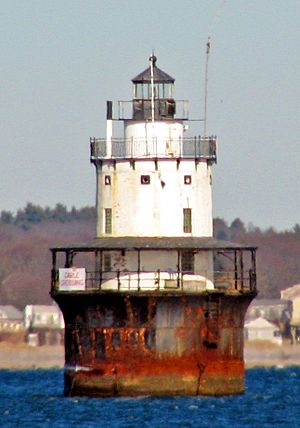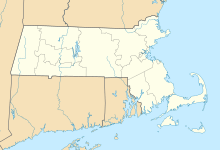Butler Flats Light facts for kids
 |
|
| Lighthouse in 2007 | |
|
|
|
| Location | New Bedford Channel, Acushnet River, New Bedford, Massachusetts |
|---|---|
| Coordinates | 41°36′13.5″N 70°53′40″W / 41.603750°N 70.89444°W |
| Year first constructed | 1898 |
| Year first lit | 1898 |
| Automated | 1978 |
| Foundation | Cast iron/Concrete Caisson |
| Construction | Brick |
| Tower shape | Conical on cylindrical base |
| Markings / pattern | White tower with black base and lantern |
| Focal height | |
| Original lens | Fifth order Fresnel lens |
| Characteristic | Flashing white 4s |
| Admiralty number | J0498 |
| ARLHS number | USA-099 |
| USCG number | 1-16853 |
The Butler Flats Light is a cool lighthouse in the outer harbor of New Bedford, Massachusetts. It sits at the mouth of the Acushnet River. This lighthouse was built way back in 1898. It's special because it's a "caisson" lighthouse. This means it has a strong, watertight base that sits on the harbor floor. It was designed by a marine architect, which is unique!
In 1978, the light became automatic, so no one had to live there anymore. Today, the city of New Bedford runs it. It helps boats find their way safely. The lighthouse was also added to the National Register of Historic Places in 1987. This means it's an important historical site.
What is the Butler Flats Light?
The Butler Flats Light is located in the outer part of New Bedford Harbor. It's near Clark's Point, which is the southernmost tip of the city. This lighthouse was put there to help ships navigate into the inner harbor. The inner harbor is further north along the Acushnet River.
The lighthouse is a "caisson tank light." It stands about 53 feet (16 m) tall. Its base is made of concrete and sits firmly on the muddy bottom of the harbor.
How is the Lighthouse Built?
On top of the caisson base, there's a round brick building. Around the lowest part of this building is a wide deck called the fog deck. This deck is a bit wider than the caisson base. It flares out to help protect the lighthouse from strong waves.
Above the brick section, there's another open deck. This is where the brick part connects to the smaller iron lantern house. A narrow third deck goes around the lantern chamber itself.
Inside, the lighthouse used to have living and dining areas. Seven crew members lived and worked there. There were also offices and storage rooms. To get into the lighthouse, you use a ladder that goes down from the fog deck.
History of the Lighthouse
The Butler Flats Light was built in 1898. It was designed by F. Abraham Smith. When it was first built, it had a fog signal too. This signal would make a loud sound to warn ships in foggy weather.
Later, a big wall called the New Bedford Hurricane Barrier was built about 0.5 miles (0.80 km) north of the lighthouse. This barrier also had a small light on it. Because of this new barrier, the Butler Flats Light was not as important for navigation anymore.
In 1978, the United States Coast Guard made the lighthouse fully automatic. This meant no one needed to live there to operate it. The fog signal was moved to the hurricane barrier.
After some local people worked hard to save it, the lighthouse was given to the city. Now, the city operates it. It still serves as a private aid to navigation, helping boats find their way.
You can't go inside the lighthouse, but it's easy to see it from the shore. You can get a good view from East Rodney French Boulevard in New Bedford. You can also see it from other spots along the city's waterfront.


